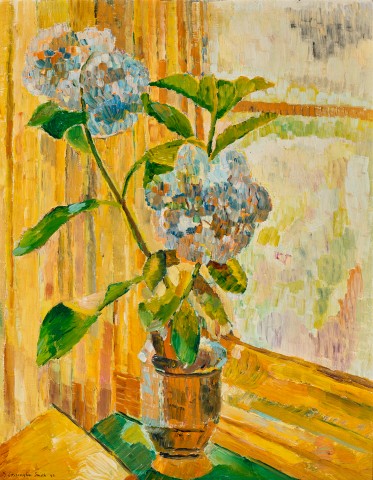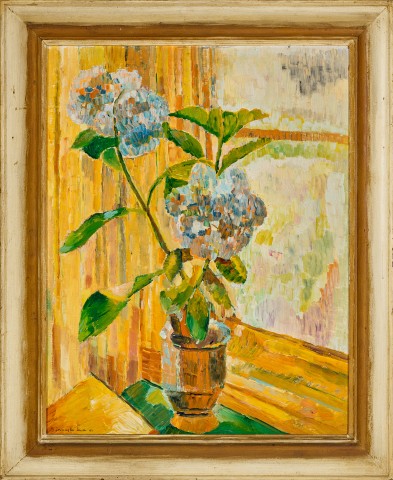Vase in the window, 1945
Grace Cossington smith
oil on compressed card
58.0 x 46.0 cm
signed and dated lower left: G. Cossington Smith 45.
signed and inscribed with title on artist’s label verso: Vase in The Window / Grace Cossington Smith
inscribed verso: Hydrangeas in the Window
bears inscription verso: PROPERTY OF MARY TURNER
Macquarie Galleries, Sydney (label attached verso)
Mary Turner, Sydney
Private collection, Sydney, acquired directly from the above
Grace Cossington Smith, Exhibition of paintings, Macquarie Galleries, Sydney, 17 – 29 September 1947, cat. 4
Private Treasure – Public Pleasure, Orange Regional Gallery, New South Wales, 5 February – 5 March 1998 (label attached verso)
‘Grace C. Smith Exhibition’, The Sydney Morning Herald, Sydney, 17 September 1947, p. 9
As was the case for many female painters of the late 19th and early 20th century, the domestic interior became the centre of Grace Cossington Smith’s artistic production, the crucible of her modernist experience. While flower pieces and still-life compositions were mainstays of Smith’s creative practice, by the 1940s, these were evolving from tightly cropped, rhythmic compositions to expanded views of still-life arrangements by the window, presented within the rooms of the house where she had lived for almost 50 years. Vase in the window, 1945, sets a spindly hydrangea cut straight from the garden against the corner of a windowsill, its blue flowerheads shimmering against an array of golden hues. Finding wonder in familiar surroundings, Smith has transformed this ordinary scene into a subtle expression of the genius loci of the home that bore her name.1
The death of the family’s patriarch, Ernest Augustus Smith, in September 1938, was a major event in the artist’s otherwise stable and quiet life – ‘rooms were purged, lives reorganised and relationships re-negotiated’2, the family home seen anew. Alongside her two unmarried sisters, Madge and Diddy, Grace gained full autonomy of the house, formally relocating her studio from the shed at the bottom of the garden. Although a few examples of imagined narrative subjects exist from the wartime period – for example, Dawn landing, 1944 and Signing, 1945 – the majority of Smith’s regular output at this time was focused on the home front, retreating indoors and producing confident still lives marked by ‘a milky consistency of touch, verging on the tonal.’3
With a stately vertical composition, Vase in the window is an early example of the artist’s celebrated paintings of a still life in the window, which reached their high-pitched apogee in the mid-1950s. The painting is vertically divided between yellow drapery on the left and, on the right, an amorphous, misty landscape seen through the windowpane, each painted with the artist’s textured square pointillism. Set against a complex geometry of diagonal and perpendicular lines from the tilted plane of the table and sill, the contours of Smith’s singular subject, alternately titled Hydrangeas in the window, shimmer with fractured brushstrokes, risking dissolution into the broader mosaic of the picture plane. Painted from the inside looking out, Smith’s interiors and still lives harness the vitality of the natural world, from ordinary cut garden blooms to the rare shafts of natural light that reached the house’s Quaker interior. More specific than the bouquets of wildflowers that proliferate around this time in Smith’s oeuvre, the common hydrangea, with its striking puffed heads and broad leaves, is elevated into a ‘flamboyant emblem of the lifeforce.’4
Vase in the window was first owned by Mary Turner, founder of Orange Regional Gallery and co-director of Macquarie Galleries, where Grace Cossington Smith faithfully exhibited her work for over forty years. The unwavering support and friendship Smith received from Turner and Macquarie Galleries was foundational to her significant artistic achievement and can be considered one of the greatest artist-patron associations in Australian art.5
1. Her mother’s childhood home, ‘Cossington Hall’, in Leicestershire, was adopted c.1920 as a both a name for the new family home in Turramurra, and Grace Smith’s artistic nom de plume.
2. James, B., Grace Cossington Smith, Craftsman House, Sydney, 1990, p. 110
3. ibid, p. 116
4. ibid, p. 147
5. Proudfoot, A., ‘Not (just) the charm school: contemporary art at the Macquarie Galleries 1938 – 1963’, The art world came to us: the Macquarie Galleries, 1938 – 1963, Ngununggula, New South Wales, 2024, p. 36
LUCIE REEVES-SMITH


